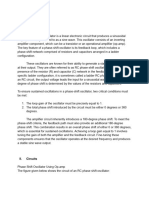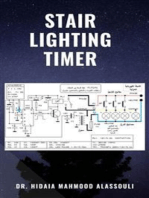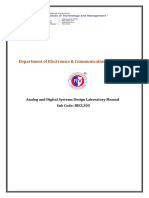Wuwe
Wuwe
Uploaded by
induja c mCopyright:
Available Formats
Wuwe
Wuwe
Uploaded by
induja c mOriginal Title
Copyright
Available Formats
Share this document
Did you find this document useful?
Is this content inappropriate?
Copyright:
Available Formats
Wuwe
Wuwe
Uploaded by
induja c mCopyright:
Available Formats
Wein bridge oscillator using transistor lab manual
The electronic circuits used to generate periodic, oscillating signals such as sine waves or square wave,s or triangular wave are known as Oscillators. Oscillators take a DC signal and convert them into the required AC signal. These are used in numerous electronic devices where a clock signal is required. Some of the applications of oscillators are
clock generators in calculators, computers, digital clocks, video games, etc… The signals generated by oscillators are also used in radio broadcasting and tuning of audio in TV.
These are classified based on their output signal frequency as Low-frequency oscillator, Radio oscillator, and RF oscillator. One such classification of the oscillator is Wein-Bridge Oscillator. What is Wien Bridge Oscillator? Wein Bridge Oscillator is an electronic device that generates sine waves. In the year 1891, Max Wein developed a bridge circuit to
measure the impedances. William R.Hewlett designed the Wein-Bridge Oscillator using the Wein bridge circuit and the differential amplifier. Here the Wein bridge is connected in a positive feedback loop between the amplifier output and differential inputs. This can also be viewed as a band-pass filter that provides positive feedback connected to a
positive gain amplifier. The bridge circuit is composed of four resistors and two capacitors. The bridge is balanced at the oscillating frequency and has a very low transfer ratio. Circuit Diagram of Wein Bridge Oscillator Wein Bridge Oscillator is a two-staged RC coupled amplifier circuit. It has a feedback loop with a series R1C1 circuit, also known as
a High-pass Filter circuit, connected to a parallel R2C2 circuit, also known as a Low-pass Filter circuit. This connection forms a selective second-order frequency-dependent Band-pass filter. This filter has a high Q- factor at a selected frequency. The component values of both the RC circuits are the same. At the resonant frequency, the phase shift of
the signal will be 0 and the circuit will have good stability and low distortions. Besides RC circuits the other two arms of the Weinbridge consist of two more resistors R3, R4. Below is the circuit diagram of a Wein bridge oscillator using OP-Amp. driving test and answers Wein bridge oscillator Circuit Diagram Using Op-Amp When higher frequencies
are applied, the reactance of the capacitors connected in the Wein-bridge is very low.
This short circuits the resistor R2 and its output voltage will be zero. espressor manual star-light emd-1515 pret At lower frequencies, the higher reactance of the capacitors is observed, and capacitor C1 acts as an open circuit thereby causing the output voltage to be zero. This feature of Wein-bridge observed at the application of lower and higher
frequencies, makes it a lead-lag circuit. Here Op-Amp is used as the non-inverting amplifier. The output voltage from the Wein-bridge is fed back to both inverting and non-inverting terminals of the Op-amp. Operation of Wein Bridge Oscillator using IC741 In a Wein bridge oscillator, when lower to higher frequencies are applied, at a particular
frequency, the value of resistance and capacitor reactance becomes equal to each other. At this point, the maximum output voltage is observed. This frequency where maximum voltage is derived is known as the “Resonance Frequency” of the Wein bridge oscillator and is denoted as fr. The formula for the calculation of resonant frequency is as follows
fr = 1/2π√(R1C1R2C2) if R1 = R2 = R and C1 = C2 = C then, fr = 1/2πRC At the resonant frequency, the phase shift between input and output will be zero. The magnitude of the output voltage will be one-third of the input voltage. The output of the op-amp is given as input to the bridge circuit from points a and c. The output from the bridge is
derived from points b and d and given as input to the op-amp. A portion of the amplifier output is feedback to the positive or non-inverting terminal of the op-amp through the voltage divider circuit, formed by the series combination of resistor and capacitor. Another portion of the output is feedback to the negative or inverting terminal of the op-amp,
through the impedance of 2R magnitude. Here, the feedback network provides zero phase shift. Since the amplifier is non-inverting it also has zero phase shift. Hence, the combination of feedback bridge and non-inverting amplifier produces zero phase shift around the loop.
Thus, the required condition for the generation of oscillations is achieved.
The circuit of the Wein bridge oscillator using IC741 is given below. Wein bridge oscillator using IC741 Automatic Gain Control To have sustained oscillations the total loop gain of the oscillator must be maintained at value 1. So, automatic gain control is required for a feedback oscillator. To achieve this a Zener diode is placed in the feedback
network in parallel with resistance R3. When the output voltage reaches the Zener breakdown voltage level, the Zener diode starts conducting. This will short circuit the resistor R3, which decreases the amplifier gain to 3 and maintains the total loop gain at 1. This method of gain control is easy but it suffers from the non-linearity of the Zener diode
which inturn causes distortion in sine waves. To overcome the limitation, JFET is placed in the negative feedback path. This JFET acts as a voltage-controlled resistance. By using JFET for automatic gain control, a stable sinusoidal waveform can be produced. Advantages Some of the advantages of the Wein-bridge oscillator are given below. The
overall gain of the oscillator is high as it uses a two-stage amplifier. As no inductors are used in the circuit, there is no issue of interference from external magnetic fields.
This oscillator produces a stable sinewave without any distortions. Here, the frequency of the oscillations can be changed by changing the values of capacitors or by the use of a variable resistor in the circuit. The Wein-bridge oscillator has good frequency stability. Disadvantages Some of the disadvantages of the Wein bridge oscillator are given
below. The two-stage amplifier type of oscillator requires more devices for construction. This oscillator cannot generate very high frequencies, because of the limitations placed on the amplitude and phase-shift values of the amplifier. Applications Some of the applications of the Wein bridge oscillator as given below. These are highly used for audio
testing. amway e84 water filter manual Clock signals for testing filter circuits can be generated by this oscillator. Used in distortion testing of power amplifiers. These are also used as excitation for the AC bridges.
Please refer to this link to know more Voltage Controlled Oscillator MCQs, Oscillators MCQs Further article related to Oscillator is UJT Relaxation Oscillator. Please refer to this link to know more about Wien Bridge Oscillator MCQs Besides the use of an op-amp for the amplifier, Wein bridge oscillators are also constructed using transistor circuits.
The various implementations of this oscillator are limited by the automatic gain control as well as the limitation of its output amplitude caused due to intentional and non-intentional linearity. What total loop gain must be maintained for the proper working of the Wien bridge oscillator? Image Credits: Wein bridge oscillator circuit diagram using Op-
Amp – EEEbooks4U Wein bridge oscillator using IC741 –elektroda Anna University – EC3462 Linear Integrated Circuits Laboratory Regulation 2021 Syllabus , Notes Lab Manual , Viva Important Questions, Question Paper with Answers Previous Year Question Paper. LIST OF EXPERIMENTS: EC3462 Linear Integrated Circuits Laboratory Lab Manual
Viva DESIGN AND ANALYSIS OF THE FOLLOWING CIRCUITS 1.
Series and Shunt feedback amplifiers-Frequency response, Input and output impedance 2. RC Phase shift oscillator and Wien Bridge Oscillator 3. Hartley Oscillator and Colpitts Oscillator 4. RC Integrator and Differentiator circuits using Op-Amp 5. Clippers and Clampers 6.
Instrumentation amplifier 7. Active low-pass, High pass & Band pass filters 8. PLL Characteristics and its use as frequency multiplier, clock synchronization 9. R-2R ladder type D-A converter using Op-Amp SIMULATION USING SPICE (Using Transistor): Lab Manual EC3462 Linear Integrated Circuits Laboratory 1. Tuned Collector Oscillator 2.
Twin -T Oscillator / Wein Bridge Oscillator 3. Double and Stagger tuned Amplifiers 4. Bistable Multivibrator 5. Schmitt Trigger circuit with Predictable hysteresis 6. Analysis of power amplifier COURSE OBJECTIVES: Lab Manual Viva ● To gain hands on experience in designing electronic circuits ● To learn simulation software used in circuit design o
learn the fundamental principles of amplifier circuits ● To differentiate feedback amplifiers and oscillators. ● To differentiate the operation of various multivibrators COURSE OUTCOMES: Lab Manual Viva At the end of the course the students will be able to Analyze various types of feedback amplifiers Design oscillators, tuned amplifiers, wave-
shaping circuits and multivibrators Design and simulate feedback amplifiers,oscillators, tuned amplifiers, waveshaping circuits and multivibrators, filters using SPICE Tool. Design amplifiers, oscillators, D-A converters using operational amplifiers. Design filters using op-amp and perform an experiment on frequency response Related Links Anna
University Syllabus Regulation 2021 Anna University Regulation 2021 Study Materials Anna University Results CGPA Calculator For Anna University Download Padeepz App for Android
You might also like
- Ecad Virtual LabDocument4 pagesEcad Virtual LabNeelimaNo ratings yet
- Free Project Circuit DiagramDocument14 pagesFree Project Circuit Diagramrasika.ouNo ratings yet
- Experiment No: 4 Title: Sinusoidal Oscillators ObjectiveDocument5 pagesExperiment No: 4 Title: Sinusoidal Oscillators ObjectiveShibeshwar MandalNo ratings yet
- Assignment 2 Industrial PDFDocument23 pagesAssignment 2 Industrial PDFZaid Masood0% (1)
- RC Phase Shift and Wien Bridge Oscillator Using OpDocument10 pagesRC Phase Shift and Wien Bridge Oscillator Using Opkeerthanamurugesan139No ratings yet
- Wien Bridge Oscillator ReportDocument5 pagesWien Bridge Oscillator ReportDerrick Sibusiso Kunene100% (1)
- Lab 8 ReportDocument8 pagesLab 8 ReportSHUBHAM GARGNo ratings yet
- Weign Bridge OscillatorDocument4 pagesWeign Bridge Oscillatormanojkumar9No ratings yet
- Lecturer4 1 OscillatorsDocument43 pagesLecturer4 1 OscillatorsAn PhạmNo ratings yet
- Linear Integrated Circuits 70 Interview Questions and Solutions 2 - DivyumDocument14 pagesLinear Integrated Circuits 70 Interview Questions and Solutions 2 - Divyumbalu56kvNo ratings yet
- Assignment No.2: Topic: OscillaDocument6 pagesAssignment No.2: Topic: OscillaMuhammad Mubashar AwaisiNo ratings yet
- Multivibrator Manual PDFDocument73 pagesMultivibrator Manual PDFAvijitRoyNo ratings yet
- Function GeneratorDocument78 pagesFunction GeneratorVishali Chowdary100% (1)
- Mit Aec Labmanula 10esl37Document45 pagesMit Aec Labmanula 10esl37anon_70724250No ratings yet
- Unit - 5 - Oscillators & TimersDocument45 pagesUnit - 5 - Oscillators & TimersHarish Kumar K.SNo ratings yet
- Sinusoidal OscillatorDocument22 pagesSinusoidal OscillatorChandrika Reddy100% (1)
- Inverting Subtractor and Voltage Controlled OscillatorDocument10 pagesInverting Subtractor and Voltage Controlled OscillatorKartheek KonaNo ratings yet
- EC6303 - Linear Integrated Circuits and Applications NotesDocument132 pagesEC6303 - Linear Integrated Circuits and Applications NotesbrsreddyNo ratings yet
- Oscillators: de La Salle University - Dasmariñas College of Engineering, Architecture, and Technology Engineering ProgramDocument9 pagesOscillators: de La Salle University - Dasmariñas College of Engineering, Architecture, and Technology Engineering ProgramJaneNo ratings yet
- Oscillator NotesDocument11 pagesOscillator NotesHarsh SinghNo ratings yet
- Assignment 2Document9 pagesAssignment 2Noor HassanNo ratings yet
- Experiment 6 7 8Document27 pagesExperiment 6 7 8Farhan AliNo ratings yet
- Tribhuwan University: Lab No:..... Sinusoidal OscillatorsDocument5 pagesTribhuwan University: Lab No:..... Sinusoidal OscillatorsKRSTNo ratings yet
- Chap 3 Signal Conditioning CircuitDocument26 pagesChap 3 Signal Conditioning CircuitMuhammed I'zwanNo ratings yet
- EMI Signal GeneratorsDocument10 pagesEMI Signal GeneratorsNaga HimanshuNo ratings yet
- VCO ReportDocument9 pagesVCO ReportGokul SaiNo ratings yet
- Analog and Digital Ic'S Short Questions With AnswersDocument41 pagesAnalog and Digital Ic'S Short Questions With Answerspriya adhavanNo ratings yet
- Oscillator CircuitsDocument19 pagesOscillator Circuits21-08523No ratings yet
- The Ua741 Operational AmplifierDocument25 pagesThe Ua741 Operational AmplifierMaribel MendezNo ratings yet
- OscillatorsDocument18 pagesOscillatorsUjjwal Jha100% (1)
- Power Amplifiers: Phase Shift OscillatorDocument3 pagesPower Amplifiers: Phase Shift OscillatorAli DurazNo ratings yet
- Implementation of Square Wave, Sine Wave, and Triangular Wave Generator Using Operational Amplifier CircuitDocument36 pagesImplementation of Square Wave, Sine Wave, and Triangular Wave Generator Using Operational Amplifier CircuitCharles BurgosNo ratings yet
- OscillatorssDocument21 pagesOscillatorssrishiNo ratings yet
- Selman Kasim Bağirici 2008514046 Signal GeneratorsDocument40 pagesSelman Kasim Bağirici 2008514046 Signal GeneratorsSelman BağırıcıNo ratings yet
- Analog Lab 8 1904132Document13 pagesAnalog Lab 8 1904132SHUBHAM GARGNo ratings yet
- Ece-IV-linear Ics & Applications (10ec46) - NotesDocument146 pagesEce-IV-linear Ics & Applications (10ec46) - NotesAnonymous n30qTRQPoINo ratings yet
- Chapter 3 - OscillatorDocument50 pagesChapter 3 - OscillatorJ A P SNo ratings yet
- Rohini 14662932072Document8 pagesRohini 14662932072vk5170No ratings yet
- Waveform GeneratorsDocument19 pagesWaveform GeneratorsChamanjeet SinghNo ratings yet
- Eee-V-linear Ics and Applications (10ee56) - NotesDocument132 pagesEee-V-linear Ics and Applications (10ee56) - NotesSai Prasanna JandhyalaNo ratings yet
- Lecture 02Document33 pagesLecture 02fabab60922No ratings yet
- EEE 2104 Lab Report 06Document6 pagesEEE 2104 Lab Report 06shohim603No ratings yet
- Half Wave Rectifier Physics Project PDF VinilDocument12 pagesHalf Wave Rectifier Physics Project PDF Vinilteamboys536No ratings yet
- Oscillators For First YearDocument21 pagesOscillators For First YearStudent HelperNo ratings yet
- Unit 2Document6 pagesUnit 2ShanilDayalanNo ratings yet
- Exp No8Document9 pagesExp No8Mohd Syamsul Ramli100% (1)
- Wien Bridge Oscillator:: RC Phase Shift Network (Lead Lag Network)Document6 pagesWien Bridge Oscillator:: RC Phase Shift Network (Lead Lag Network)Rashid ManzoorNo ratings yet
- Analog Circuits and Simulation LabDocument77 pagesAnalog Circuits and Simulation LableevasusanNo ratings yet
- III Sem Lab ManualDocument19 pagesIII Sem Lab ManualHima G RajNo ratings yet
- Ec1 2205 QBDocument27 pagesEc1 2205 QBklnayaagiNo ratings yet
- ELE324 Oscillators L3 V2Document55 pagesELE324 Oscillators L3 V2Eduar MhangoNo ratings yet
- Full Report - E1Document13 pagesFull Report - E1Naddy MohdNo ratings yet
- Reference Guide To Useful Electronic Circuits And Circuit Design Techniques - Part 1From EverandReference Guide To Useful Electronic Circuits And Circuit Design Techniques - Part 1Rating: 2.5 out of 5 stars2.5/5 (3)
- Reference Guide To Useful Electronic Circuits And Circuit Design Techniques - Part 2From EverandReference Guide To Useful Electronic Circuits And Circuit Design Techniques - Part 2No ratings yet
- STEM: Science, Technology, Engineering and Maths Principles Teachers Pack V10From EverandSTEM: Science, Technology, Engineering and Maths Principles Teachers Pack V10No ratings yet
- Analog Dialogue, Volume 48, Number 1: Analog Dialogue, #13From EverandAnalog Dialogue, Volume 48, Number 1: Analog Dialogue, #13Rating: 4 out of 5 stars4/5 (1)
- Mechanics Module 4Document18 pagesMechanics Module 4induja c mNo ratings yet
- Mechanics Module 3Document32 pagesMechanics Module 3induja c mNo ratings yet
- Morden Physics 3Document4 pagesMorden Physics 3induja c mNo ratings yet
- Module 05 Developmental Process - Western and Eastern PerspectivesDocument2 pagesModule 05 Developmental Process - Western and Eastern Perspectivesinduja c mNo ratings yet
- Morden Physics 2Document5 pagesMorden Physics 2induja c mNo ratings yet
- Module 04 Stress According To Eastern PerspectiveDocument3 pagesModule 04 Stress According To Eastern Perspectiveinduja c mNo ratings yet
- Module 02 Introduction To Yoga For Stress Management - 2Document2 pagesModule 02 Introduction To Yoga For Stress Management - 2induja c mNo ratings yet
- Alcohols Phenols & Ethers Notes PDFDocument83 pagesAlcohols Phenols & Ethers Notes PDFinduja c mNo ratings yet
- 12 Chemistry Notes ch13 AminesDocument11 pages12 Chemistry Notes ch13 Aminesinduja c mNo ratings yet
- Answer and Solutions - JEE - Main 2023 - PH 1 - 25 01 2023 - Morning - Shift 1 PDFDocument25 pagesAnswer and Solutions - JEE - Main 2023 - PH 1 - 25 01 2023 - Morning - Shift 1 PDFinduja c mNo ratings yet
- Answer and Solutions - JEE - Main 2023 - PH 1 - 24 01 2023 - Evening - Shfit 2 PDFDocument24 pagesAnswer and Solutions - JEE - Main 2023 - PH 1 - 24 01 2023 - Evening - Shfit 2 PDFinduja c m100% (1)
- Op Amp ReportDocument57 pagesOp Amp ReportvenkateshNo ratings yet
- 155 Lic Part 1Document192 pages155 Lic Part 1RamakrishnaNo ratings yet
- New Revised 4 Sem SyllabusDocument18 pagesNew Revised 4 Sem Syllabusprashantkumar chinamalliNo ratings yet
- Analog Electronics Workbook PDFDocument43 pagesAnalog Electronics Workbook PDFGokul GNo ratings yet
- Analog Signal Conditioning: Compiled By: Prof. G B Rathod EC Dept., BVM Email: Ghansyam - Rathod@bvmengineering - Ac.inDocument81 pagesAnalog Signal Conditioning: Compiled By: Prof. G B Rathod EC Dept., BVM Email: Ghansyam - Rathod@bvmengineering - Ac.inRuchit PathakNo ratings yet
- Operational AmplifiersDocument53 pagesOperational AmplifiersengrNo ratings yet
- Op Amp Topologies As Excerpted From Op Amp Applications: BryantDocument8 pagesOp Amp Topologies As Excerpted From Op Amp Applications: BryanttihomihoNo ratings yet
- Practice Mod 5Document72 pagesPractice Mod 5Abdul rahman bin Ahmad YusoffNo ratings yet
- ESA Lab Report #1 - OP AmpsDocument9 pagesESA Lab Report #1 - OP AmpsAndrew Jordan YancoffNo ratings yet
- EEE 4308L Electronics I Laboratory Laboratory #1 Operational Amplifier-Based IntegratorsDocument19 pagesEEE 4308L Electronics I Laboratory Laboratory #1 Operational Amplifier-Based IntegratorsnoneNo ratings yet
- Active Filter Cookbook: Don Lancaster'sDocument240 pagesActive Filter Cookbook: Don Lancaster'sclaudio lopesNo ratings yet
- Linear Integrated Circuits Unit2 Raghudathesh VTUDocument45 pagesLinear Integrated Circuits Unit2 Raghudathesh VTUraghudatheshNo ratings yet
- Operational Amplifiers: Basic Building Block Black BoxDocument27 pagesOperational Amplifiers: Basic Building Block Black BoxAyesha GuptaNo ratings yet
- Expt 4Document14 pagesExpt 4Krunal PatelNo ratings yet
- Operational AmplifiersDocument14 pagesOperational AmplifiersAyhan AbdulAzizNo ratings yet
- Alexander Ch05 PPT Fund Elec Circ 6e ADocument30 pagesAlexander Ch05 PPT Fund Elec Circ 6e Akero8sabryNo ratings yet
- UNIT 3 - A Analog Integrated CircuitsDocument82 pagesUNIT 3 - A Analog Integrated CircuitsMohit ApteNo ratings yet
- Malvino: MCQ in Nonlinear Op Amp Circuits: Topic OutlineDocument6 pagesMalvino: MCQ in Nonlinear Op Amp Circuits: Topic OutlineHardik PatelNo ratings yet
- Topic 7 Signal ConditioningDocument118 pagesTopic 7 Signal ConditioningMuhammad Adib HaikalNo ratings yet
- Analog and Digital Ele Krishna University PDFDocument58 pagesAnalog and Digital Ele Krishna University PDFChandar Rao Veeranki100% (1)
- Chapter 10 (Part Ni Solo)Document10 pagesChapter 10 (Part Ni Solo)edward solomonNo ratings yet
- Lic Lab MannualDocument103 pagesLic Lab MannualAnusha NatarajanNo ratings yet
- Ae Practical MCQDocument13 pagesAe Practical MCQDeependra SinghNo ratings yet
- Linear and Digital Ic Applications RRDocument8 pagesLinear and Digital Ic Applications RRNizam Institute of Engineering and Technology LibraryNo ratings yet
- Questionaires No. 02 PDFDocument21 pagesQuestionaires No. 02 PDFEr Raushan Kumar YadavNo ratings yet
- ElECTRONIC CKTSDocument544 pagesElECTRONIC CKTSNavaraj BaniyaNo ratings yet
- St. Thomas College of Engineering & Technology Kozhuvalloor: (Answer Any Two Questions)Document2 pagesSt. Thomas College of Engineering & Technology Kozhuvalloor: (Answer Any Two Questions)syulmnmdNo ratings yet
- Updated - Analog & Digital Circuit Manual - BECL305Document98 pagesUpdated - Analog & Digital Circuit Manual - BECL305rvit22bec032.rvitmNo ratings yet
- Physics Honors Sem 4 Syllabus - Delhi UniversityDocument10 pagesPhysics Honors Sem 4 Syllabus - Delhi UniversityAstha YadavNo ratings yet
- Opamp ApplicationDocument38 pagesOpamp ApplicationS.m. FerdousNo ratings yet




































































































